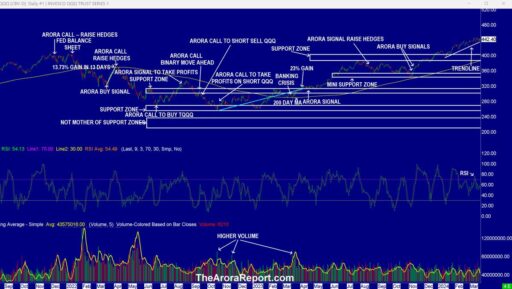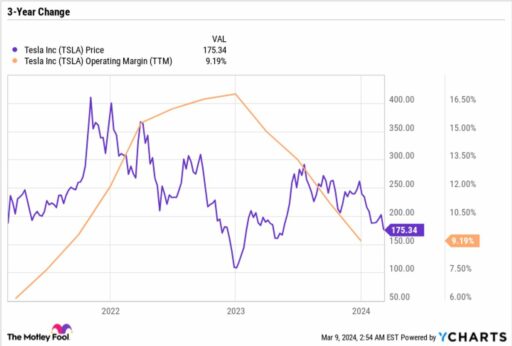Marathon Digital Holdings (NASDAQ:MARA) has recently caught the attention of investors and analysts alike, with its stock experiencing significant fluctuations and drawing interest from contrarian investment strategies. Understanding the nuances of MARA stock is crucial for investors looking to make informed decisions. This guide delves into MARA’s financial health, stock momentum, investment strategies, and the role of AI in stock analysis, providing a comprehensive overview for potential and current investors.
Key Takeaways
- MARA stock is favored by the Contrarian Investor model, indicating potential for those willing to invest in unpopular mid- and large-cap stocks with improving fundamentals.
- Despite strong recent momentum, MARA’s stock performance should be evaluated in the context of key financial indicators like earnings growth, intrinsic value, and ROE.
- Technical analysis reveals volatility with the stock dropping below the 50-day EMA and retesting crucial support levels, suggesting short-term price movements may be unpredictable.
- Investment strategies for MARA should consider both the impact of its fundamentals on long-term value and the implications of short-term market volatility on trading decisions.
- AI-powered analysis is becoming increasingly relevant, offering a new perspective on risk assessment and trading strategies for stocks like MARA.
Analyzing Marathon Digital Holdings’ Financial Health

Earnings Growth and Market Valuation
Earnings growth is a crucial factor in assessing a stock’s valuation. For Marathon Digital Holdings, the revenues increased 452% to $156.8 million in the fourth quarter of 2023, a significant leap from the previous year. This surge suggests a robust upward trajectory in the company’s financial performance. However, it’s essential to determine if this growth is already reflected in the market price or if there are discrepancies suggesting a mispriced opportunity.
When considering Marathon Digital Holdings’ market valuation, several key metrics come into play. The company’s past earnings growth, return on equity (ROE), and reinvestment strategies provide insights into its potential for future profitability. Despite a high ROE and substantial profit reinvestment, the company’s earnings growth has been modest, hinting at external factors influencing its growth prospects.
Analysts are cautiously optimistic, projecting a slight improvement in earnings growth. This anticipated change could offer some solace to investors concerned about the company’s performance.
Lastly, a review of Marathon Digital Holdings’ valuation metrics reveals mixed signals. While some indicators like the current ratio and return on equity pass muster, others such as the P/E ratio and price-to-book value fail to impress. Investors should weigh these factors carefully to make informed decisions.
Key Financial Indicators and Stock Performance
When evaluating Marathon Digital Holdings’ stock performance, investors often turn to key financial indicators to gauge the company’s health and potential for growth. The stock’s recent performance on the NASDAQ Stock Exchange reflects a dynamic market position, with a notable 12-month increase of 153.21%, despite a slight dip of 2.82% over the past three months.
| Period | Performance |
|---|---|
| 3 months | -2.82% |
| 12 months | 153.21% |
These figures highlight the stock’s volatility and the importance of understanding the underlying financial metrics that drive such movements. Investors should consider a range of indicators, including earnings growth, debt levels, and cash flow, to form a comprehensive view of MARA’s financial stability and long-term viability.
While the table above provides a snapshot of recent performance, it is crucial for investors to delve deeper into Marathon Digital Holdings’ financial statements and market trends to make informed decisions.
Assessment of MARA’s Intrinsic Value
When assessing the intrinsic value of Marathon Digital Holdings, investors must consider various financial metrics and models. Intrinsic value is a measure of what an asset is worth, derived from objective calculations or complex financial models. For MARA, this involves analyzing past earnings growth and how the market has priced in the company’s expected earnings trajectory.
The intrinsic value is a critical factor in determining whether MARA is undervalued or overvalued by the market.
Here’s a snapshot of MARA’s key financial indicators:
| Indicator | Status |
|---|---|
| Market Cap | PASS |
| Earnings Trend | PASS |
| EPS Growth Rate | FAIL |
| P/E Ratio | FAIL |
| P/CF Ratio | FAIL |
| P/B Value | FAIL |
| P/D Ratio | FAIL |
| Current Ratio | PASS |
| Payout Ratio | PASS |
| Return on Equity | PASS |
| Pre-Tax Profit Margins | PASS |
| Total Debt/Equity | PASS |
These indicators suggest that while MARA has strong fundamentals in certain areas, it fails to meet the criteria in others, such as EPS growth rate and valuation ratios. This mixed picture can influence the perceived intrinsic value and, consequently, investment decisions.
MARA’s Stock Momentum: A Technical Perspective

Recent Price Movements and Volume Analysis
Marathon Digital Holdings Inc. (MARA) has exhibited notable price movements in the recent trading sessions. Volume analysis indicates a divergence between price and volume, suggesting that investors should monitor the stock closely for potential changes. Despite an uptick in price, the volume has decreased, which could signal a lack of conviction in the price increase and may foreshadow a reversal.
The stock’s behavior shows that falling volume on higher prices may be an early warning sign of upcoming shifts in the market.
The following table summarizes key trading levels for MARA based on Fibonacci support and resistance calculations:
| Level | Price | Change % |
|---|---|---|
| R3 | $21.23 | +9.90% |
| R2 | $20.33 | +5.25% |
| R1 | $19.78 | +2.37% |
| S1 | $17.98 | -6.94% |
| S2 | $17.42 | -9.82% |
| S3 | $16.52 | -14.48% |
Additionally, the stock has been labeled as "very high risk" due to its significant daily volatility, with a wide prediction interval from the Bollinger Bands and large intraday price movements.
Technical Indicators and Their Implications
Technical indicators are crucial tools for traders and investors looking to understand the momentum and potential future movements of MARA stock. The Relative Strength Index (RSI), for example, is a momentum oscillator that measures the speed and change of price movements. MARA’s RSI values, which oscillate between 25 and 75, indicate whether the stock is in an overbought or oversold condition.
Another significant indicator is the use of pivot points, which help in identifying potential support and resistance levels. These levels are pivotal to determining entry and exit points for traders. The table below summarizes key technical indicators and their recent readings for MARA stock:
| Indicator | Description | Recent Reading |
|---|---|---|
| RSI | Momentum oscillator that measures overbought or oversold conditions | 25 – 75 |
| Pivot Points | Used to identify potential support and resistance levels | Varies daily |
While these indicators provide valuable insights, they should not be used in isolation. Combining multiple indicators can offer a more comprehensive view of the stock’s technical landscape.
Support and Resistance Levels for MARA
Understanding the support and resistance levels for Marathon Digital Holdings (MARA) is crucial for traders looking to capitalize on the stock’s price movements. Support levels are prices at which buyers are expected to enter the market, preventing the stock from falling further, while resistance levels are prices at which selling is expected to occur, capping the stock’s upward potential.
The table below summarizes the recent support and resistance levels based on accumulated volume and Fibonacci retracements:
| Level | Type | Price (USD) | Percentage Change |
|---|---|---|---|
| R3 | Resistance | 23.89 | +23.65% |
| R2 | Resistance | 23.49 | +21.58% |
| R1 | Resistance | 22.40 | +15.94% |
| S1 | Support | 18.98 | -1.76% |
| S2 | Support | 17.78 | -7.97% |
| S3 | Support | 16.13 | -16.51% |
Marathon Patent finds support from accumulated volume at $18.98, and this level may hold a buying opportunity as an upwards reaction can be expected when the support is being tested.
It’s important to note that these levels are not static and can change with market dynamics. The stock’s recent dip below the 50-day Exponential Moving Average and the downward trend indicated by the Relative Strength Index (RSI) suggest potential volatility ahead. Investors should monitor these levels closely as they can provide valuable insights into potential entry and exit points.
Investment Strategies for MARA Stock

Contrarian Approach Based on David Dreman’s Model
David Dreman’s contrarian investment strategy is renowned for its focus on undervalued stocks with potential for improvement. MARA’s current market position may align with Dreman’s model, which seeks out mid- and large-cap stocks that are unpopular yet show signs of fundamental progress. This approach involves a rigorous analysis of financial indicators to identify such investment opportunities.
The following table summarizes MARA’s performance against Dreman’s key financial criteria:
| Financial Metric | MARA Performance | Dreman’s Criteria |
|---|---|---|
| Earnings Trend | Pass | Pass |
| EPS Growth Rate | Fail | Pass |
| P/E Ratio | Fail | Pass |
| Price/Cash Flow Ratio | Fail | Pass |
| Price/Book Value Ratio | Fail | Pass |
| Price/Dividend Ratio | Fail | Pass |
| Current Ratio | Pass | Pass |
| Payout Ratio | Pass | Pass |
| Return on Equity | Pass | Pass |
| Pre-Tax Profit Margins | Pass | Pass |
| Total Debt/Equity | Pass | Pass |
Investors should note that while some financial metrics align with Dreman’s criteria, others do not, indicating a mixed assessment. This necessitates a deeper dive into MARA’s fundamentals before making investment decisions.
By applying Dreman’s principles, investors can potentially uncover value in MARA stock that the market has overlooked. However, it is crucial to remember that this strategy requires patience and a long-term perspective.
Understanding the Impact of MARA’s Fundamentals on Investment Decisions
When considering an investment in Marathon Digital Holdings (MARA), it’s crucial to delve into the company’s fundamentals. The market’s valuation of MARA hinges on its financial health and growth prospects. An analysis of MARA’s earnings growth, for instance, can reveal whether the stock is currently overvalued or undervalued relative to its future earnings potential.
Investors should scrutinize MARA’s key financial metrics, such as the P/E ratio, current ratio, and return on equity, to gauge the company’s profitability and financial stability.
Understanding these fundamentals is not just about the numbers; it’s about interpreting what they mean for MARA’s future. Here’s a snapshot of MARA’s financial health based on recent data:
| Metric | Status |
|---|---|
| Market Cap | Pass |
| Earnings Trend | Pass |
| EPS Growth Rate | Fail |
| P/E Ratio | Fail |
| Price/Cash Flow Ratio | Fail |
| Price/Book Value | Fail |
| Current Ratio | Pass |
| Payout Ratio | Pass |
| Return on Equity | Pass |
| Pre-Tax Profit Margins | Pass |
This table highlights areas where MARA meets or falls short of key financial benchmarks, which can inform investment decisions and strategies.
Long-Term Predictions Versus Short-Term Volatility
Investors often grapple with the challenge of balancing long-term predictions against short-term volatility. MARA’s stock, with its high volatility, exemplifies this dilemma. On a day-to-day basis, the stock can exhibit significant price swings, as evidenced by a recent daily movement of $2.36, or 13.47%. This volatility is further highlighted by the stock’s performance over the last week, with an average daily volatility of 12.31%.
While short-term traders may thrive on this volatility, long-term investors must consider the underlying trends and resist the urge to react to every price fluctuation.
For those looking to establish a position in MARA, understanding the resistance and support levels can be crucial. Here’s a succinct view of the recent resistance levels:
| Resistance Level | Price ($) |
|---|---|
| First Level | 20.48 |
| Second Level | 22.73 |
A break above these levels could signal a buy, while a pivot top point sell signal suggests caution. It’s important to note that the long-term average is currently above the short-term average, indicating a general sell signal. Investors should consider setting a stop-loss to manage risk, although no specific stop-loss level is recommended at this time.
In conclusion, while MARA’s stock may tempt with potential for quick gains, a disciplined approach focused on long-term value is essential. Stocks seldom transition smoothly from a downtrend to an uptrend, and those that turn up amidst a horizontal trend may be seen as potential ‘runners’.
The Role of AI in Analyzing MARA Stock

AI-Powered Stock Analysis and Risk Assessment
The integration of AI in stock analysis has revolutionized the way investors assess risk and make decisions. AI algorithms can now predict stock volatility, offering a nuanced understanding of potential price movements. For Marathon Digital Holdings (MARA), AI-powered tools have identified key volatility indicators.
AI’s predictive capabilities extend beyond traditional analysis, providing a comprehensive risk assessment that adapts to MARA’s dynamic market conditions.
The recent analysis by StockInvest.us suggests a volatile ride for MARA, with significant price fluctuations within a single trading day. This underscores the importance of AI in navigating the stock’s short-term volatility. The table below presents a snapshot of MARA’s technical signals:
| Indicator | Value |
|---|---|
| RSI Low | 25 |
| RSI High | 75 |
| Recent Price Movement | $17.48 – $19.84 |
While AI offers advanced insights, investors should consider the inherent uncertainties of relying solely on algorithmic predictions. Diversifying analysis methods and staying informed on sector trends remain crucial for a balanced investment strategy.
How AI Interprets MARA’s Trading Strategy
Artificial Intelligence (AI) has become a pivotal tool in interpreting the trading strategies of stocks like Marathon Digital Holdings (MARA). AI algorithms can dissect vast amounts of historical and real-time data to identify patterns and trends that may not be immediately apparent to human analysts. For MARA, AI-powered analysis often involves examining price and volume transformations, such as moving averages, to forecast future movements.
AI’s ability to process and analyze data at an unprecedented scale allows for a nuanced understanding of MARA’s market behavior.
The table below summarizes the AI analysis of MARA’s recent trading activity:
| Date | Opening Price | Closing Price | Volume |
|---|---|---|---|
| Mar 15, 2024 | $19.32 | $19.84 | High |
| Mar 11, 2024 | $17.48 | $17.48 | Moderate |
This quantitative approach is complemented by qualitative assessments, such as the stock’s beta and alpha, which provide insights into its risk profile and performance relative to the market. By integrating these analyses, AI offers a comprehensive view of MARA’s trading strategy, aiding investors in making informed decisions.
The Future of Stock Analysis with AI Technology
As the landscape of stock analysis evolves, AI technology stands at the forefront, transforming how investors interpret data and make decisions. The integration of AI into stock analysis tools has led to more sophisticated risk assessments and trading strategies, tailored to the unique characteristics of stocks like MARA.
The potential of AI to analyze vast datasets and uncover patterns offers a strategic edge to investors, enabling them to make more informed decisions amidst the volatile nature of the stock market.
The use of AI in stock analysis is not just about automation; it’s about enhancing human decision-making with machine precision. For MARA stock, AI-driven tools can provide a focused analysis, considering both historical trends and current market dynamics. This dual approach ensures a comprehensive understanding of the stock’s potential.
Here are some key benefits of AI in stock analysis:
- Enhanced predictive analytics for forecasting stock movements
- Dynamic risk assessment models that adapt to new information
- Real-time analysis of market sentiment and investor behavior
While AI’s role in stock analysis is still maturing, its impact is undeniable. Investors who leverage AI tools are better equipped to navigate the complexities of the market and identify opportunities that might otherwise be overlooked.
Conclusion
In summary, MARA stock presents a complex but intriguing investment opportunity. The stock has demonstrated strong momentum with an 89% increase over the past three months, yet it faces volatility and has recently dipped below its 50-day Exponential Moving Average. While the Contrarian Investor model based on David Dreman’s strategy shows a 57% rating, indicating some interest, the stock fails to meet several key financial metrics such as EPS growth rate and P/E ratio. Investors should weigh the positive outlook from the stock’s ROE and market support levels against the potential risks highlighted by its recent performance and technical indicators. As with any investment, due diligence and a careful study of MARA’s financial prospects are essential. The stock’s journey ahead may be a volatile ride, but for those willing to embrace the uncertainty, it could also offer substantial rewards.
Frequently Asked Questions
What is the current financial health rating of Marathon Digital Holdings (MARA) according to the Contrarian Investor model?
Marathon Digital Holdings (MARA) has a financial health rating of 57% based on the Contrarian Investor model, which follows the strategy of David Dreman.
How has MARA stock performed in the recent months?
MARA stock has seen a significant increase, with its share price rising by approximately 89% over the last three months.
What key financial indicator should investors focus on for Marathon Digital Holdings?
Investors should focus on Marathon Digital Holdings’ Return on Equity (ROE) as a key financial indicator.
Has MARA stock recently experienced any technical movements?
Yes, MARA stock has dropped below the 50-day Exponential Moving Average and retested a crucial support level at $19.83.
What are the current support and resistance levels for MARA stock?
The current support levels for MARA are at $18.98 (S1), $17.78 (S2), and $16.13 (S3), while the resistance levels are at $22.40 (R1), $23.49 (R2), and $23.89 (R3).
What is the ticker symbol for Marathon Digital Holdings and where is it traded?
The ticker symbol for Marathon Digital Holdings is MARA, and it is traded on the NASDAQ Stock Exchange.





